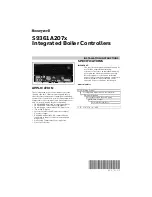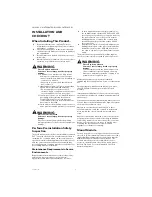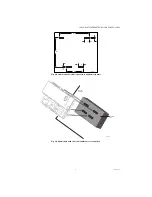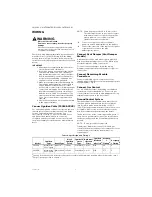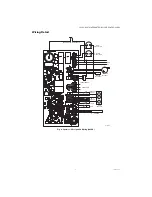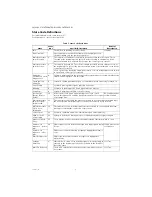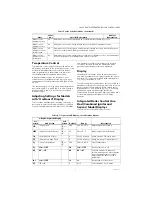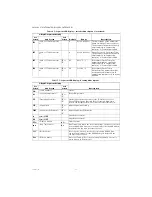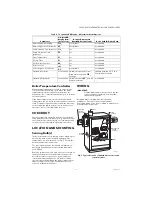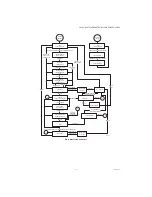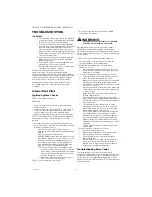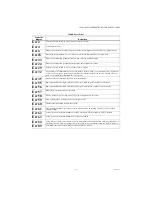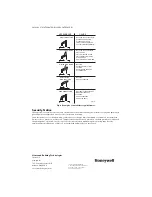
S9361A207X INTEGRATED BOILER CONTROLLERS
69-2751—05
12
Mounting Sensor and
Thermowell
The remote upper temperature sensor is installed in
an immersion well (Fig. 6) that extends into the supply
water side of the boiler.
Immersion Well Fitting
The immersion well must snugly fit the sensing bulb
for good thermal response. Install as follows:
1.
Use tapping provided by tank manufacturer, if
possible, or select an area where typical water
temperature is best measured.
2.
If tank is filled, drain to below point where bulb
will be installed.
3.
Screw well into tank.
4.
Insert bulb into well, pushing wires until bulb
bottoms in well.
5.
Attach mounting clamp end of well spud.
6.
With mounting clamp attached to well spud
(make sure jaws of clamp hook over ridge at end
of spud, as shown at points A in Fig. 6), adjust
sensing leadwire to fit through mounting clamp
groove, as shown at point B in Fig. 6.
7.
Tighten draw nut until mounting clamp is firmly
attached to well spud and wires are held securely
in place.
CAUTION
Do not secure draw nut so tightly that
mounting clamp collapses tubing.
Fig. 6. Immersion well fitting for sensor.
Wiring
Disconnect power supply before installation to
prevent electrical shock or equipment damage. All
wiring must comply with local codes and ordinances
regarding wire size, type of insulation, enclosure, etc.
OPERATION AND
CHECKOUT
Operation
The S9361A207x continuously monitors the
temperature of the boiler water and enables or
disables the burner based on this temperature data. In
general, when a “Call for Heat” occurs, the ignition
portion of the control module proceeds through the
steps necessary to start the burner and heats the
water in the boiler until the setpoint temperature is
achieved. At this point the burner is de-activated, the
ignition module completes the heating cycle, returns
to idle and waits for the temperature to drop again.
The circulator is turned on throughout the “Call for
Heat.”
See Fig. 7 for a graphical representation of a simple
control cycle. Note that the setpoint differential may
vary based on OS number.
High Limit Controller
All models include a 3-wire temperature sensor
interface, “Boiler temperature,” which is utilized for
High Limit functionality in addition to the
thermostatic control of the water heater burner. If the
temperature sensor ever indicates a temperature
above the maximum limit then the control enters over
temperature mode. In over temperature mode no
heating will occur.
Fig. 7. Basic control algorithm example.
Thermal Purge Operation
Thermal Purge Feature
When there is a Heat Request active, the circulator will
be started and boiler firing will be delayed until the
inferred heat load cannot be met by the residual heat
of the water in the system.
Boiler Firing Pre-purge
After a Heat Request is detected, the system pump is
started and the Pump pre-purge Timer starts. Boiler is
off during Pump pre-purge time.
Boiler Firing Pre-purge Expiration
After Pump pre-purge timer reaches its maximum
given by Pump Pre-purge Time parameter and the
Heat Request is still active, the boiler is started.
Boiler Firing Pre-purge Termination
If boiler firing is postponed and water temperature
drops below 140 °F (field adjustable), the boiler shall
be started after a 15 second delay regardless of the
Pump pre-purge timer value. When a Heat Request is
detected and the boiler water temperature is already
less than 140 °F (field adjustable), the boiler start
sequence is initiated after 15 seconds regardless of
the Pump pre-purge timer value. Once the boiler is
started, the Pump pre-purge timer is considered to be
expired until the next heating cycle.
SENSOR WIRES
M23086A
HEAT-CONDUCTIVE COMPOUND
(OPTIONAL)
BOILER
IMMERSION
WELL
SENSOR
M27000
SETPOINT
GAS VALVE OFF
GAS VALVE ON
70°F (21°C)
200°F (93.3°C)
15°F (8°C)
DIFFERENTIAL

